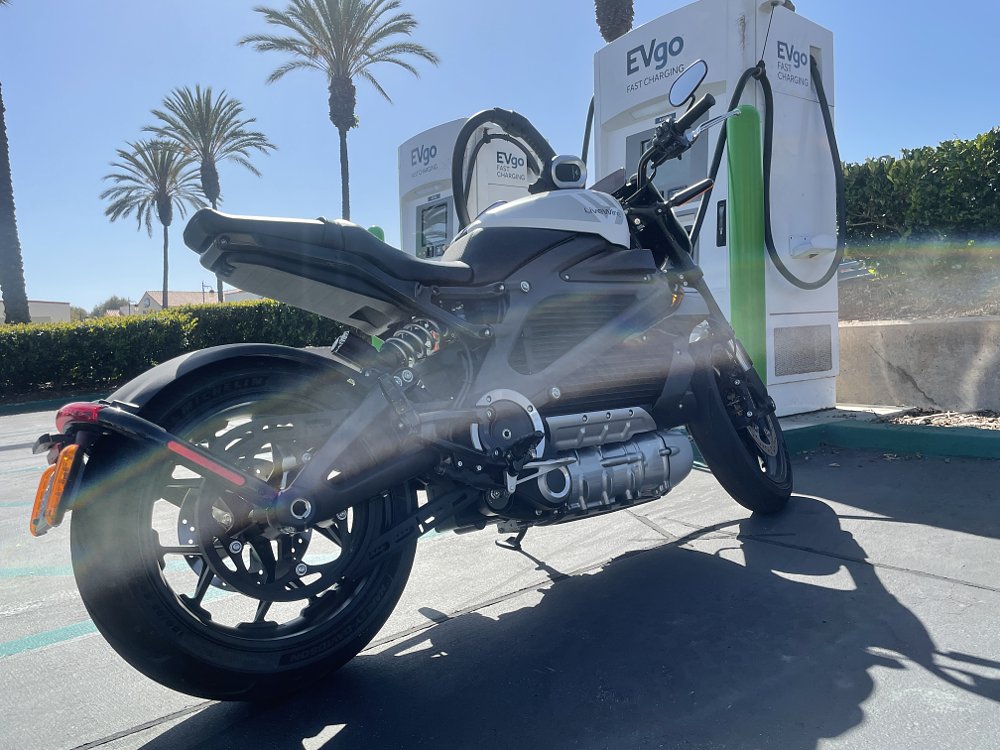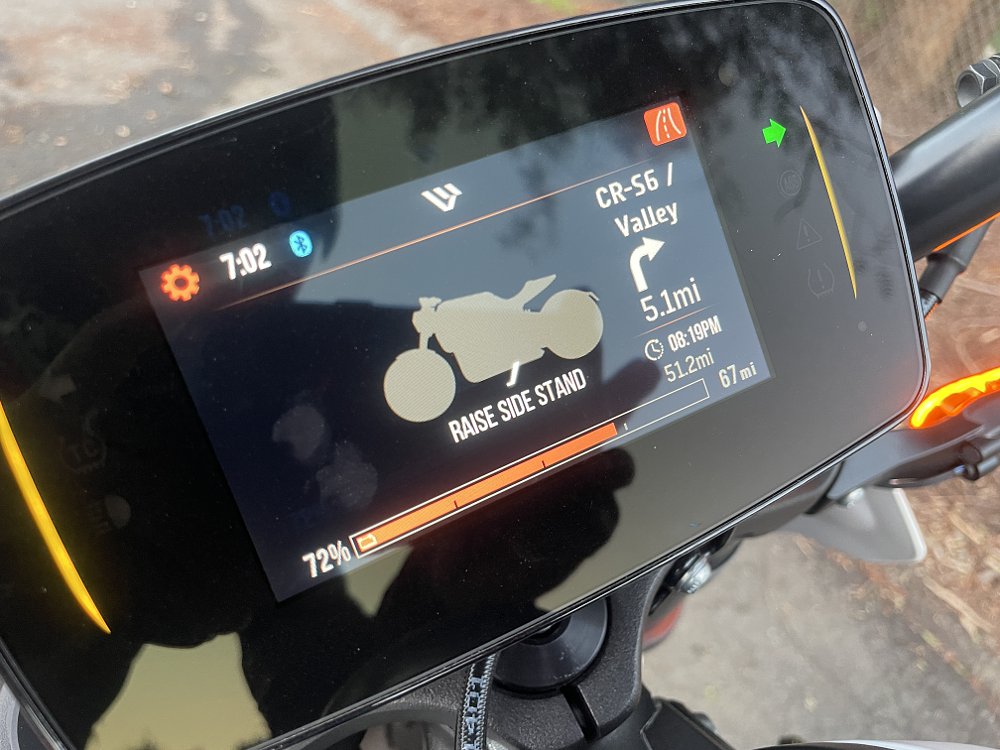“So how far can you go on that thing?” or “How long does it take to charge?” These are the two top questions, always, when it comes to electric vehicles. The LiveWire ONE is no different.
Yet these two questions, as important as they are, distract from the deeper query that needs to be answered. Who is the LiveWire ONE for? I set out on a quest to discover who can benefit most from the LiveWire ONE’s benefits while being held back least by its limitations. Nearly a month of riding and many miles of burning electrons revealed some unexpected truths.
The electric riding experience
But first, a few words on the electric motorcycle riding experience. While the internet is flush with demo videos and first ride reviews on board the LiveWire ONE, please allow this veteran electron burner to pile on just a few more opinions and first ride impressions. As an Alta Motors MX and EX owner, I’ve got several years of experience doing the electric slide in the dirt, but a dedicated street e-motorcycle was a new adventure for me.

The LiveWire ONE makes good on all the promises of EV instant acceleration and exhilaration. The lack of a clutch or gear shift lever may at first trick you into reaching for phantom levers, but my experience is that you quickly adjust. Of the utmost pleasant surprise to me was the motorcycle’s cornering competency, despite its 562 pounds. With all that weight relatively low and equipped with Showa suspension and Brembo brakes, the LiveWire ONE exceeded my expectations on the curvy mountain roads during my long-ride expedition.

Finally, the inescapable and always controversial issue — noise. We’ve said it before here on Common Tread and Highside Lowside podcast, loud pipes probably don’t save lives. If you are relying on exhaust noise to help keep you safe on the streets, you are already on your back foot for street survival. As a defensive riding proponent, my usual assumption that no car can see me or hear me was dialed up to eleven while riding the LiveWire.
The positive side is that the quietness of electric motorcycles offers a whole new riding experience. With an electric motor and belt drive, the Livewire will take you as close as possible to the sensation of riding the wind. In many ways, the noise and vibration of the typical ICE dull the senses and some might argue even detract from the ride.
But back to the question of who can live happily with the LiveWire ONE. I did two specific tests to see how it worked, one for the commuter and one for the weekend rider. Here’s how it went.
The ultimate commuter?
First, I tested the LiveWire ONE as a commuter. The average American commute is approximately 27.6 minutes and 15 miles one way. It often involves a few exits on the freeway and then a bunch of stop-and-go at city speeds. On paper, this all bodes well for the LiveWire ONE. With a claimed 146 miles of range at city speed limits, or a 95-mile range in combined highway and city use, the LiveWire can easily tackle the average round-trip commute on a single charge.

Starting with a fully charged battery, I toggled into Road mode and rode my first leg of 34 miles on primarily uninterrupted agrestic roads in the 55 to 70 mph range. I pulled into the charging station with 74 percent of charge left, an overabundance of kilowatt-hours (kwh) to make it back home if I wanted to.
I was eager to learn the ways of the DC fast charge but there was a small problem — a car beat me to the punch and was already plugged in.
Luckily, where there is a Level 3 DC fast charger, Level 1 or Level 2 chargers are usually not much farther away. A quick scoot to the next port and I was plugged in, but what was supposed to take a few minutes at DC charge would end up taking three hours and seven minutes on the slower Level 1 charger.
As Jake Bright noted in his comparison of the LiveWire and the Zero SR/S Premium, the LiveWire provides options for either Level 1 or Level 3, while the Zero offers Level 1 or Level 2. That means the LiveWire can recharge much faster, but only if you can find an available Level 3 station.
Level 1, a regular 120-volt outlet, gives you about 10 percent of battery refueled per hour of charge time. In theory, if a commuter could use about 70 percent of the LiveWire battery capacity to get to work, plug in while working an eight-hour shift, and have a full battery at the end of the work day to make it home.

A commuter test ride isn’t complete without some congested rush hour suburban traffic, so I took the busy city blocks home for a taste of the LiveWire in the concrete jungle. For starters, the LiveWire will not get hot in slow-speed, stop-and-go traffic like most other bikes. It ran cool as a cucumber in the unseasonable 90-degree weather and that was a very welcome benefit. Other items in the plus category were no clutch manipulation or tedious gear shifting.
Every inch forward at red lights and the creeping in long lines of traffic were a simple twist of the wrist, and the manageable seat height and low center of gravity meant no fatiguing one-foot balancing acts.
Commuting in city traffic plays to all the obvious strong points of an EV. But what about the weekend? I set my sights on some of my fellow SoCal riders’ favorite waypoints and packed for an all-day excursion to test the Livewire as a weekend warrior steed.

The weekend ride, micro charging all the way
Having kept the Alta dirt bikes going at demo rides at the motocross track, this ain’t my first electric rodeo, and I know the key to making a battery last all day long. That key is micro charging. Every stop, every chance you get, you plug into the juice. With this strategy in mind, I opened up the laptop and plotted a route with multiple charge stops utilizing Rever, Google maps, ChargePoint, EVgo, and the LiveWire app.

If five different apps sound like overkill, they might be. Yet this process uncovered another important piece of the LiveWire rider persona puzzle: Meticulous planners will be greatly rewarded, but aimless roamers will likely end up frustrated on the long-distance ride. Between Rever and Google, I had a good grip on mileages and surrounding amenities for stops. With ChargePoint and EVgo, I could get live information on charger availability status and fees, and with the LiveWire app I cross-referenced charger compatibility and could run navigation directly to the TFT dash.
I wanted my “weekend warrior” route to include as much variety as possible: fast freeway stints, the tight curves of the infamous Ortega Highway, flowing wide open roads, and the bustle of beach city traffic. If the LiveWire could survive this 230-mile all-day route, then it would be sufficient for a vast majority of riders.

The first leg of my trip took me down familiar roads to my reliable DC fast charge station in Temecula. The 34-mile, 52-minute back country road ride resulted in burning 24 percent of my battery power. I plugged into the Level 3 charger and had a 23-minute charge time, just long enough for a walk to the nearest coffee shop to recharge my own battery and use the restroom.
All topped off, the LiveWire and I hit the I-15 freeway for a 20-mile, 20-minute highway commute to Lake Elsinore at the base of the Ortega Highway. I didn’t hold back, and with the LiveWire in road mode we loped along with the traffic at what we will call “California freeway” pace. With a 26 percent battery burn, it was a toss of the coin if I should bother with this next scheduled charge station stop I had planned, but I wanted to make sure the LiveWire was at peak performance for the rigors of Ortega, so another 26-minute charge and some “stimulating the economy” (i.e. shopping) in the nearby Lake Elsinore Outlets commenced.
Sport mode engaged, I giddily saddled up for the mountain ridge pass. The next 37 miles and 52 minutes of corners and sweepers went by all too fast. A racy neon blue Mustang helped keep my pace honest on the fabled road. This spurt of sporty riding climbing up some elevation cost me a 33 percent depletion, and I was pretty hungry for lunch myself at this point, so a 35-minute lunch break charge was in order at the beachside town of San Clemente.
Back at a full 100 percent battery once more, it was now time for the inevitable wrong-turn conundrum to upset all this careful planning. It turns out the “fun roads” I had tried to plan my ride on to avoid the I-5 coastal freeway were mostly on the Camp Pendleton Marine base — whoops! It wasn’t a huge blow to my battery life to turn around at the base gate, but it was a reminder that wrong turns can happen and to always keep some buffer in those battery calculations for the occasional setback. I re-routed to the I-5, popped off to enjoy the views at Tamarack Surf Beach, trundled around the downtown district of Carlsbad, and then found my nearest DC fast charge station located at the Carlsbad Outlets. My unplanned foray had cost me approximately 50 miles and 60 minutes of ride time and left me with a 55 percent charge in the powerbank.
I was a little taken aback by the estimated 57-minute charge time — wasn’t it only supposed to be a 60-minute charge time on DC fast charge for a dead empty battery? I’ll get into this more in the “what I didn’t like section,” but to bring this ride to a close, I wandered yet another shopping outlet and ate too much delicious ice cream as I let the LiveWire charge to full capacity.
Why full capacity? Because I was going to need it for this final stint of the ride, the non-stop ambitious jaunt from the coastline directly back to my home at the inland foothills of San Diego.

This “Hail Mary moment” was the most difficult part for me, because once I left the hubbub of the cities and suburbs my opportunities for DC fast charging, or any charging, were going to drop off dramatically. It was going to be a real test of faith onboard the LiveWire. The one hour and 45 minutes and 85 miles were theoretically within the claimed mixed range of 95 miles on the LiveWire website. Just how “mixed” were these miles in this range test, and were they going to play nice with my particular “mix”? It was time to find out for sure what the LiveWire could do.
I rode with confidence in Road mode until I reached the 50 percent battery mark with still some sizable miles to cover and swapped into the Range mode to help improve my odds of making it home. As nighttime crept in, the country roads I normally adored began to feel a little extra desolate. Without the heat or reassuring vibrations or rumble of a traditional motorcycle, the LiveWire evoked feelings of loneliness I did not expect.
Yet even through this dark, bleak moment, the LiveWire didn’t give up or let me down. I turned onto my road with a whoop of joy and when I parked it for the night I still had 22 percent battery in the tank, a very comfortable buffer and almost spot on to the LiveWire website’s suggested range. I had done it; a respectable, all-day weekend-warrior ride from mountains to sea in SoCal. More importantly, I had fun doing it, too.
What I didn’t like about living with the LiveWire ONE
When you buy a LiveWire ONE, you also buy into the entire electric charging apparatus. My month-long experience using every manner of charging station left me wanting.
Nearly every interaction I had at a charge station had some hiccups. Many error screens on the charger or the LiveWire, I often had to move from one port to another as one kiosk simply would not charge (or slowly, like my stop at the Carlsbad charger), and the limitation that the LiveWire will not charge at Level 2, but only Level 1 or Level 3. At first I chalked it up to new user error, but after my eighth or so stop and experiencing so many inconveniences (and confirming with other folks charging their EVs that they had similar issues), it’s clear to me there are still some kinks in the electric food chain.

Specifically for the LiveWire ONE, I noticed a lot of bugs and crashes when using the app. I would carefully plot a ride in the app, push the button to navigate only to watch the entire app go black and close on my phone. When I was successful in getting the navigation to work and display on the TFT screen, I had several instances where it froze on the first step of the navigation and so I would need to pull over and restart the navigation. Normally, on a second try it would stick.
Technology is wonderful when it all works seamlessly, but at this point of the game both the LiveWire and the charging network still have some growing up to do before it is a carefree endeavor.
To EV or not to EV
So who is that rider who can make the most of what the LiveWire ONE has to offer? My riding and research narrowed it down to two rider personas: the consistent commuter and the meticulous road tripper.
The consistent commuter is the rider who has the same exact commute into the workplace every day, that falls anywhere into the 70 percent battery capacity range of the LiveWire and has access to a workplace outlet to charge all day (or a nearby DC fast charger for a quick lunch break juice up). The consistent commuter will be a huge beneficiary of all the LiveWire’s strong suits — lane splitting through traffic (if a California dweller), no engine heat, no fatiguing clutch work or gear shifting, and a considerable savings in fuel and maintenance costs.
Just how much money can the consistent commuter save compared to other vehicles? I did the math below to help best illustrate the value of the LiveWire as a grocery getter.
| Commute fuel cost comparison | |||
|---|---|---|---|
| Bike | mpg | Cents per mile | Cost of 65-mile commute |
| LiveWire ONE | 2.17 | $1.41 | |
| BMW R 1250 GS | 40 | 14 | $9.10 |
| H-D Pan America | 46 | 12 | $7.80 |
| Honda NC700X | 64 | 9 | $5.85 |
| Honda Grom | 120 | 5 | $3.25 |
| Notes: LiveWire ONE “MPGe” calculated based on reported kWh expenditure in app at current SDG&E utility price. All other miles per gallon figures averaged from internet sources, and price per mile calculated at current $5.90 price per gallon in the San Diego County market. | |||
As for the meticulous road tripper, if you are already a rider who likes to plot your weekend in advance to the windiest roads, coolest cafes, and photo-worthy destinations, then the LiveWire can slot right in with your calculations. I actually had fun seeking out charge stops with the most amenities and points of interest around them. Instead of zipping in and zipping out, like most usual gas stops, I really took in the scenery — made notes of the delicious Cuban empanada restaurant around the corner or the cute boutique specializing in up-cycled gifts. Not to mention I got to meet a lot of neat individuals at charging stations. When you own an e-motorcycle like the LiveWire, you become part of a very rare and exclusive club. Even Tesla owners come over and gawk at the LiveWire ONE.
The question you need to ask yourself is: Are you a pioneer or a settler? The LiveWire and e-motorcycles like it exist on the new EV frontier and, yes, there are still mysteries, challenges, and rewards waiting for those who want to discover it.

























